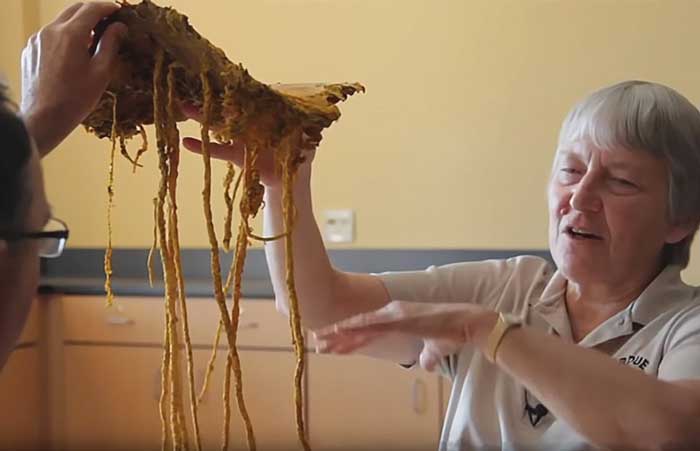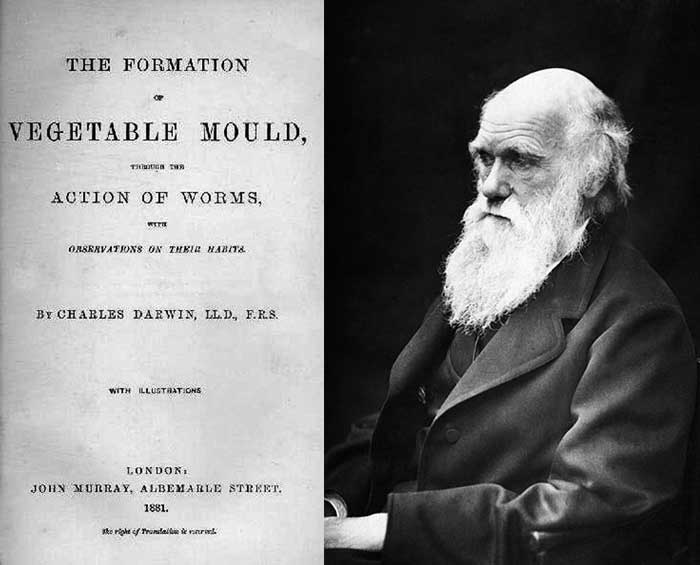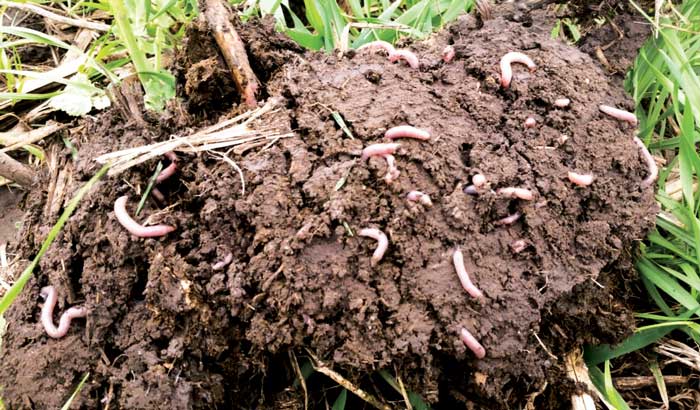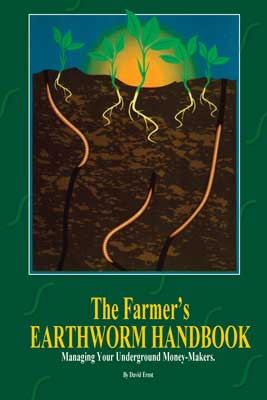The quest for no-till history research of the last couple years turned up the still-accessible web musings of the late Ed Winkle of Ohio’s Hymark Consulting (No-Till Innovator alum) who was one of ag’s earliest bloggers. One of his “essays” suggested that no-till’s vital “tool” — the earthworm — may not have been indigenous to the U.S. Theories include arrival in North America via ship ballast or imported potted plants and online debates follow. But Winkle’s writing tagged it for inclusion in the “history topics” file folder.
If the mission of this ongoing history series is to chronicle the people and tools responsible for making no-till a practical reality, the earthworm deserves to emerge from the darkness. As you’ll read below, the impact of the nightcrawler didn’t hit mass understanding until the start of no-till’s third decade.
Someone else will need to decide the chicken-egg question about no-till and the earthworm. But serendipitous byproduct of the anti-plow movement or not, the earthworm has been instrumental in a 33-fold increase in U.S. no-till acreage in the last 50 years.
Godmother of Earthworms
No-Till Innovator Eileen Kladivko (see April 21, 2022, episode of the No-Till Farmer podcast) arrived at Purdue University in 1982 to join the teams of D.R. Griffith and J.V. Mannering. She recalls her early readings of research papers on infiltration and permeability, and noticed several “casual” mentions of earthworms that piqued her curiosity and area of study.
“Europe, Australia and New Zealand were studying earthworms, but almost no one was in the U.S.,” she says. “There was Agricultural Research Service scientists Bill Edwards (Ohio) and Dennis Linden (Minnesota) and me.”

INFILTRATION ILLUSTRATED. Purdue University’s Eileen Kladivko holds a liquid latex poured into earthworm middens, evidence of how channels can be as deep as 3 feet. USDA NRCS
Along the way, Edwards took a year of study in Europe under W. Ahlers, who’d written a paper on the worm’s role in water infiltration. “It was a very good scientific literature review but was not written for farmers,” Kladivko says. “But it got Edwards interested in the subject.”
When asked if earthworms’ role in no-till was understood in the 1960s-70s, Kladivko bristled with a resounding no.
“The understanding of earthworms came later, and when it hit, the reaction was crazy. By the late 1980s every one of the no-till meetings had to have an earthworm speaker on the agenda, including yours (National No-Tillage Conference) and Monsanto’s in 1993.”
Prior to the work of the trio of U.S. earthworm researchers, Kladivko said the last study in the U.S. was in the 1940s, at the New Jersey experimental stations. (See the February 2023 edition on Ohio’s Bill Haddad replicated those trials in the early 1970s to try to convince farmers to look at no-till’s benefits.)

UNDERSTANDING SOILS. Charles Darwin’s 1881 book on earthworms, The Formation of Vegetable Mould through the Action of Worms, is considered the first scholarly treatment of soil-forming processes. According to Charles Darwin & Earthworms, Darwin’s “uncle showed him a spot in his garden where he had spread ashes and lime several years before. Darwin was amazed to see how soil cast up by earthworms had buried the substances. He went home and began a series of earthworm experiments that would go for the next 40 years. Darwin conducted both lab experiments in his study and billiard room and field investigations in his extensive gardens.”
The article noted that his book sold 6,000 copies in its first year, selling faster than On the Origin of Species had when it was first published.
Kladivko says key developments in the farm science of earthworms came from Clive Edwards (the UK earthworm scientist who emigrated to the U.S. and Ohio State, and who wrote on the biology of earthworms) and Australia’s Ken Lee, who added several works relative to tillage in the mid-1980s.
In a 2000 No-Till Farmer article, Linden explained that field populations of as many as half a million worms per acre can create 250 miles of tunnels each week.
“The plow is one of the most ancient and most valuable of man’s inventions; but long before he existed, the land was in fact regularly plowed and still continues to be thus plowed by earthworms. It may be doubted whether there are many other animals which have played so important a part in the history of the world, as have these lowly organized creatures.…” – Charles Darwin, whose last book, published in 1881, was devoted to earthworms
“The shallow-dwellers’ tunnels create space for air and water in the soil, while nightcrawler burrows improve drainage and water infiltration.” Though shallow-dwellers’ burrows can fill with water during a rainstorm, they tend to drain quickly, notes Linden. “The soil will take a lot of water, but it won’t stay long, so it won’t get saturated and anaerobic.”
Farm Practice Effects
A 2017 Scientific American (SA) report by Christopher Intagliata examined the fascinating study of earthworms in no-tillage by European soil experts Olaf Schmidt and Maria Briones, and how farmers saw earthworm populations double after the switch to no-till. Their 65-year examination of global farm-field studies resulted in widely cited research published by Global Change Biology in 2017.

UNDERGROUND ALLIES. University of Maryland researcher Ray Weil says high-quality soils no-tilled for more than 20 years likely contain 1 ton per acre of earthworms, a level 10 times greater than heavily tilled soils, greatly improving soil structure, nutrients and biological activity. Tom Cotter
Titled “Conventional tillage decreases the abundance and biomass of earthworms and alters their community structure in a global meta-analysis,” it examined the relationship between tilling and the health of a dozen species of earthworms.
The SA article provided Schmidt’s explanation. “They live all their life in a single vertical channel in the soil. And at night they surface,” looking for food — manure, straw, stuff like that — to pull into their channels.
“They found that in heavily plowed fields, half the earthworms had disappeared,” writes Intagliata, pointing out how tillage chops them, exposes them to birds and destroys their channels.
“The more you till, the less they have to eat,” confirmed Sharon Weyers, USDA soil scientist in the Wall Street Journal’s (WSJ) coverage of the same study.
“But when farmers switched to no-till or conservation agriculture, worm populations wriggled back to normal numbers after about a decade,” wrote Intagliata. “And, Schmidt says, just as the worms look after the soil, the flip side’s true, too. ‘If you look after the soil, you also look after the earthworms.’”

ALL-TIME BEST SELLER. The Farmer’s Earthworm Handbook: Managing Your Underground Money-Makers, remains No-Till Farmer’s best-selling book. It’s still regarded as the most practicable resource for farmers on the soil health value of your “underground livestock.”
Down the Wormhole
A few more observations on your earthworm friends that burrowed their way into our review.
- Need to convince a naysayer to no-till? Do the “kick-away” test of nudging residue away to show the midden activity in a no-till vs. conventional field.
- How important are earthworms? No-Till Legend Jim Kinsella of Illinois needs no convincing about the asset’s value. Kinsella is known to stop his truck on rainy highways to retrieve earthworms he’ll put back into his fields.
- 'Seeding’ nightcrawlers? Iowa no-tiller David Kusel did so and saw a doubling in earthworm populations in one year and an expansion in area by 2.5 times, demonstrating their movement. The earthworm-seeded no-till fields also showed a visible difference in the devouring of residue from an adjacent field.
- The WSJ’s coverage of the 2017 study summarized how earthworms improve the structure and fertility of soil by working organic material into the dirt, providing channels that make it easier for water and oxygen to penetrate it and converting nutrients into forms plants can readily absorb.
- Wired reported in 2000 that Charles Darwin may have spent as much time thinking about earthworms as evolution. In addition, he “understood that England’s lush topsoil was the product of ceaseless soil consumption and defecation by earthworms: about 54,000 per acre, depositing 10 tons of fresh soil atop each acre of countryside, every single year.”
- A common question in ag circles remains how to feed an exploding world’s population. Deep-thinking no-tillers also ask how to feed the exploding populations of earthworms. Take the farmer who told us he wasn’t interested in the trending topic of short-stature corn. Why? Because it’d greatly reduce the residue feedstock he needs to keep his earthworms happy and healthy.
The 2024 No-Till History Series is supported by Calmer Corn Heads. For more historical content, including video and multimedia, visit No-TillFarmer.com/HistorySeries.








Post a comment
Report Abusive Comment